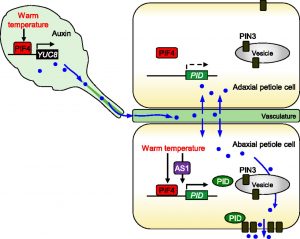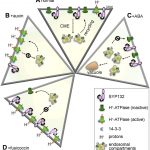Insights into Thermonastic Leaf Movements
Many plant species actively reorient their organs in response to dynamic environmental conditions. Petiole hyponasty is an upward movement of petioles driven by a higher rate of cell expansion on the lower (abaxial) compared with the upper (adaxial) side. Hyponasty is common among rosette species facing environmental stresses such as flooding, proximity of neighbors or elevated ambient temperature. Thermally induced nastic leaf behaviors are termed leaf thermonasty and may play a role  in protecting heat-sensitive tissues from the radiant heat of the soil surface. Park et al. (10.1104/pp.19.00139) demonstrate that a developmentally regulated polarity of auxin flow underlies thermonasty in Arabidopsis (Arabidopsis thaliana). Under warm conditions, the transcription factor PHYTOCHROME-INTERACTING FACTOR4 (PIF4) stimulates auxin production in the leaf. This results in the accumulation of auxin in leaf petioles, where PIF4 directly activates a gene encoding the PINOID (PID) protein kinase. PID is involved in polarization of the auxin transporter PIN-FORMED3 to the outer membranes of petiole cells. The leaf polarity-determining ASYMMETRIC LEAVES1 (AS1) directs the induction of PID to occur predominantly in the abaxial petiole region. These observations indicate that the integration of PIF4-mediated auxin biosynthesis and polar transport, and the AS1-mediated developmental shaping of polar auxin flow, coordinate leaf thermonasty, which facilitates leaf cooling in warm environments.
in protecting heat-sensitive tissues from the radiant heat of the soil surface. Park et al. (10.1104/pp.19.00139) demonstrate that a developmentally regulated polarity of auxin flow underlies thermonasty in Arabidopsis (Arabidopsis thaliana). Under warm conditions, the transcription factor PHYTOCHROME-INTERACTING FACTOR4 (PIF4) stimulates auxin production in the leaf. This results in the accumulation of auxin in leaf petioles, where PIF4 directly activates a gene encoding the PINOID (PID) protein kinase. PID is involved in polarization of the auxin transporter PIN-FORMED3 to the outer membranes of petiole cells. The leaf polarity-determining ASYMMETRIC LEAVES1 (AS1) directs the induction of PID to occur predominantly in the abaxial petiole region. These observations indicate that the integration of PIF4-mediated auxin biosynthesis and polar transport, and the AS1-mediated developmental shaping of polar auxin flow, coordinate leaf thermonasty, which facilitates leaf cooling in warm environments.



